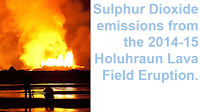NASA has released the first set of images from its new Tropospheric Emissions: Monitoring of Pollution (TEMPO) satellite, which is intended to measure the concentrations of pollutant gasses over North America, and which was launched April 2023. The images, featured in a press release issued on 24 August 2023, shows the distribution of nitrogen dioxide, which is produced as a biproduct of burning fossil fuels and which is harmful to the respiratory tract, around major cities, and thoroughfares in North America on 2 August 2023.
Nitrogen dioxide levels over the DC/Philadelphia/New York region at 4:24 p.m. on 2 August 2023, as measured by TEMPO. Kel Elkins/Trent Schindler/Cindy Starr/NASA Scientific Visualization Studio.
The satellite has been placed in a geostationary orbit 35 400 km above the equator and will continuously monitor an area between the Atlantic Ocean to the east, the Pacific Ocean to the west, the latitude of Mexico City to the south, and approximately mid-Canada to the north. It forms part of a network which now monitors much of the Northern Hemisphere for atmospheric pollution, including the South Korean Geostationary Environment Monitoring Spectrometer, and the European Space Agency's Sentinel 4 satellite.
Image showing nitrogen dioxide levels over Southern California at 12:14on 2 August 2023, as measured by TEMPO. Kel Elkins/Trent Schindler/Cindy Starr/NASA Scientific Visualization Studio.
The TEMPO satellite works by monitoring wave lengths at which gas molecules emit light. All molecules will absorb light at some wavelengths and emit it at others, and spectrographic instruments such as TEMPO are able to utilise this to determine the presence and concentration of individual molecules. For example, nitrogen, which makes up 80% of the Earth's atmosphere, emits light in the blue part of the spectrum, giving the sky its distinctive blue colour. Nitrogen dioxide has a distinctive orange-brown colour, while gasses such as methane and carbon dioxide radiate light in the infra-red part of the spectrum, which we experience as heat, leading to them being regarded as greenhouse gasses.
See also...








